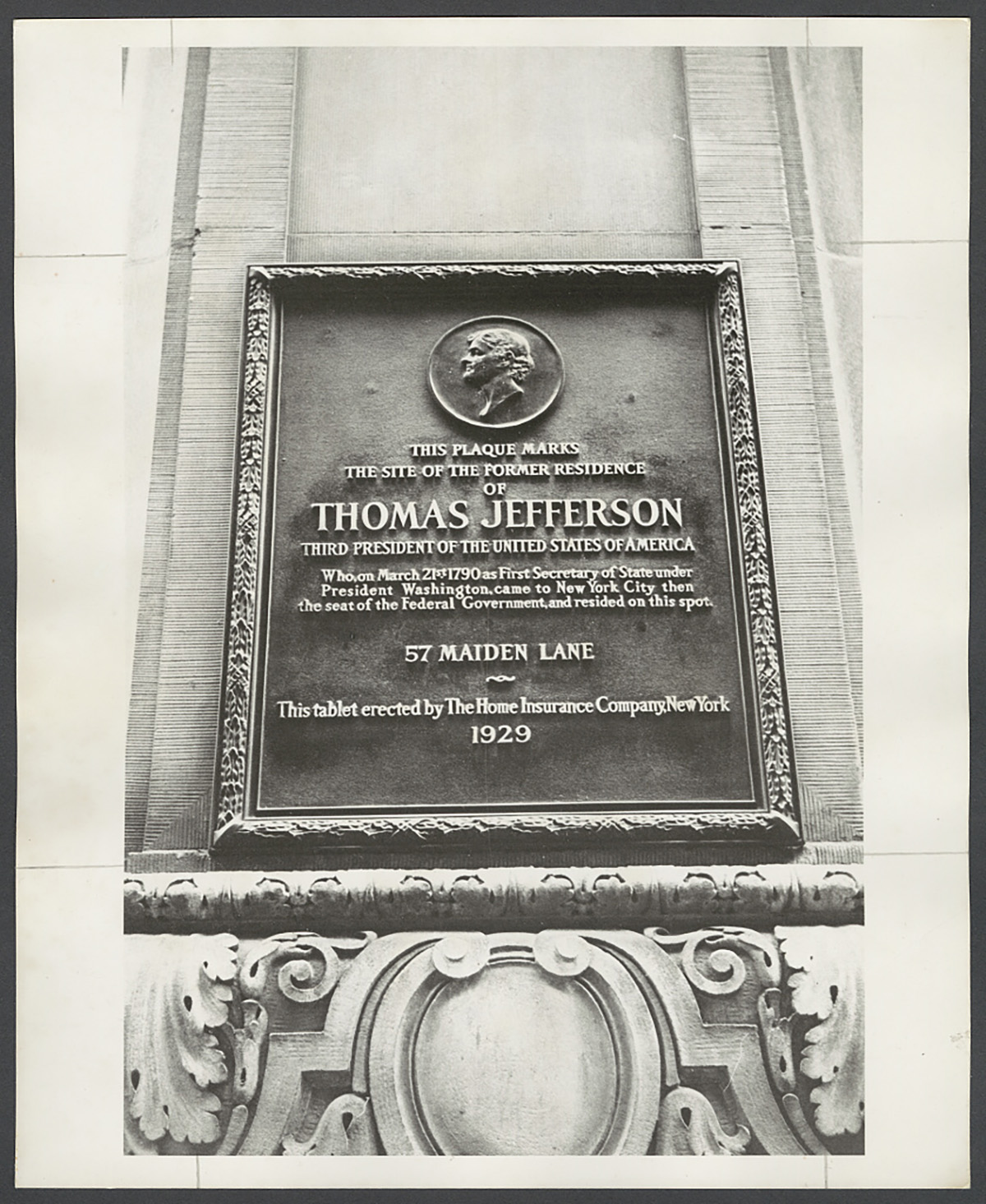Thomas Jefferson first visited New York City in May 1766, but little is known of his itinerary.[1] He wrote that, on the way, his horse ran away twice and he almost drowned in fording a river.[2] He later mentioned that he stayed at the same boardinghouse as Elbridge Gerry, a future advocate for the Republican cause.[3] He then visited New York again in June 1784 on his way to Boston to sail for Paris.[4] He stayed at Dorothy Elsworth's boardinghouse on 19 Maiden Lane for six nights, visited a bookshop at 1 Queen Street, took a ferry to and from Long Island on June 1, and on June 6 lodged at "Wilson's" at Fort Washington.[5]
Jefferson did not return to New York City until 1790 as a forty-seven-year-old international celebrity and secretary of state. Although Jefferson spent less than six months in residence, during this time he organized the first Patent Office, coordinated diplomatic affairs with Europe, served as Washington's assistant, and worked out a compromise with James Madison and Alexander Hamilton on a Federal assumption of state debts in return for a permanent capital on the Potomac.
 Plaque marking the location of Jefferson's residence at 57 Maiden Lane in New York City
Plaque marking the location of Jefferson's residence at 57 Maiden Lane in New York CityAfter leaving Monticello on March 1, 1790, and spending a week in Richmond, Jefferson arrived in New York City on March 21, accompanied by his enslaved bodyservant, Robert Hemmings. On this journey, he encountered 18 inches of snow and had to give up his own carriage and horses in Alexandria; the roads were so bad that the stage he rode in did not go more than three miles per hour.[6] Upon arrival, he paid portage at the City Tavern (torn down in 1793), which was located on the block between Cedar and Thames Streets, at 115 Broadway, next to Trinity Church. He probably resided at Mrs. Dunscomb's boardinghouse on 22 King Street, however, until he moved into his own place on June 2. He wrote to his daughter Martha: "I find it difficult to procure a tolerable house here. ... I have taken an indifferent one nearly opposite Mrs. Elsworth's which may give me time to look about me and provide a better before the arrival of my furniture."[7] His house, located at 57 Maiden Lane, was rented from Robert and Peter Bruce, grocers at 3 Front Street, "for a year @ £100."[8] St. John de Crèvecœur wrote that Jefferson "Lived in a Mean House in Maiden Lane and not approving much of the Stiff Style and Etiquette of New York he gave up all his Time to the Establishment of his new department, foreign affairs and Home."[9] To his home he added a multi-windowed gallery in the back for his papers, books, and plants. A plaque erected in 1921 by the Home Insurance Company commemorates Jefferson's place of residence in the former capital.
Many venues in New York City have Jefferson associations. On July 10, Jefferson traveled to Fort Washington (near West 183rd Street) on the northern end of Manhattan with President Washington. They dined at Washington's 1776 headquarters, the present Morris-Jumel Mansion on West 160th Street and Edgecomb Avenue. On July 13, Jefferson took plants to Charles Brannon's "Tea Garden" (Spring and Hudson Streets) and went on excursions to Brooklyn, Jamaica, and Flushing (site of William Prince's nursery). He borrowed a book from the New York Society Library in City Hall, went to Hell Gate, and purchased many items, including an engraving of Joseph Wright's portrait of Washington and Bartram's Travels through North and South Carolina, Georgia, East & West Florida. He dealt with many merchants, whose names and locations are generally known. For example, he purchased Madeira from James Farquhar, a merchant at 5 Hanover Square; a revolving chair and its companion sofa from Thomas Burling, the well-known cabinetmaker at 36 Beekman Street; and china and glass from William Williams at 80 William Street and 30 Maiden Lane. He paid Ignatius Schnydore at 28 John Street for a fresco painting and Effingham Lawrence, a druggist at 227 Queen Street, for red bark and toothbrushes.
Although Jefferson did not have extensive ties with New York City again, except as a starting point for his tour of upstate New York and New England at the end of May 1791, it was in New York City that the Thomas Jefferson Memorial Foundation formed in 1923 to acquire Monticello and turn it into a "national shrine." The majority of people who signed the Certificate of Incorporation were New York City residents, and their offices were located on 115 Broadway, the former site of the City Tavern where Jefferson had "paid portage" 133 years before. The current structure at 115 Broadway, known as the U.S. Realty Building, was constructed in 1906-1907 and was one of the earliest Gothic-inspired skyscrapers in New York City. It was designated a New York City Landmark in 1988.
In 1932, during the Great Depression, the Foundation moved its offices to 70 Pine Street, where they were able to secure free rent for a period of two years. 70 Pine Street was a brand-new Art Deco-style office building; at the time, it was the tallest building in Lower Manhattan at 67 stories. It was designated a New York City landmark in 2011.
- Rebecca Bowman, 10/98; updated by Anna Berkes, 3/19/24
ADDRESS:
1050 Monticello Loop
Charlottesville, VA 22902
GENERAL INFORMATION:
(434) 984-9800
